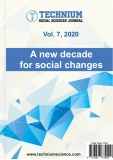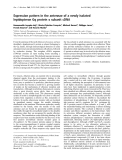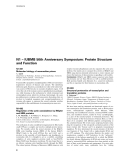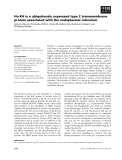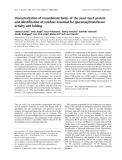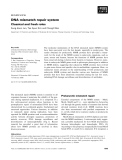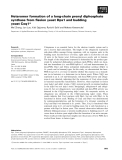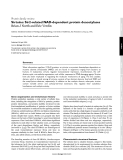
The organ systems of humans
-
This study explores the implementation of digital human resource management (HRM) practices within organizations through a qualitative lens. Semi-structured interviews were conducted with nine employees and managers to understand their experiences and perceptions of digital HRM systems.
 8p
8p  viyuhi
viyuhi
 26-03-2025
26-03-2025
 1
1
 1
1
 Download
Download
-
The human organism is a biophysical system. Stress represents a normal reaction of the organism which appears as a response to an aggression situation which requires an unusual and quick adaptation effort from the organism.
 9p
9p  christabelhuynh
christabelhuynh
 04-06-2020
04-06-2020
 34
34
 4
4
 Download
Download
-
This chapter provides knowledge of cell cycle. The main contents of this chapter include all of the following: List the phases of the cell cycle and describe the key events of each phase, describe the process of DNA replication.
 9p
9p  tangtuy07
tangtuy07
 02-04-2016
02-04-2016
 33
33
 2
2
 Download
Download
-
From the antennae of the moth Mamestra brassicae, we have identified a lepidopteran G protein a subunit belonging to the Gq family, through immunological detection in crude antennal extract and antennal primary cell cultures, followed by molecular cloning. The complete cDNA sequence (1540 bp) contains an open reading frame encoding a protein of 353 amino acids.
 10p
10p  research12
research12
 01-06-2013
01-06-2013
 26
26
 4
4
 Download
Download
-
Transmissible spongiform encephalopathies (TSE) are fatal neuro-degenerative diseases of humans and animals. The underlying infectious agent, the prion, accumulates not only in the central ner-vous system (CNS) but also in secondary lymphoid organs. I will revisit the role of the immune system in peripheral prion pathogen-esis, while focusing on the mechanisms by which extraneural and extralymphatic prion infectivity develops.
 64p
64p  fptmusic
fptmusic
 11-04-2013
11-04-2013
 37
37
 4
4
 Download
Download
-
Hu-K4 is a human protein homologous to the K4L protein of vaccinia virus. Due to the presence of two HKD motifs, Hu-K4 was assigned to the family of Phospholipase D proteins although so far no catalytic activity has been shown. The Hu-K4 mRNA is found in many human organs with highest expression levels in the central nervous system. We extended the ORF of Hu-K4 to the 5¢ direction. As a consequence the protein is 53 amino acids larger than originally predicted, now harbouring a putative transmembrane domain....
 0p
0p  awards
awards
 06-04-2013
06-04-2013
 39
39
 3
3
 Download
Download
-
Prion diseases are characterized by the accumulation of a pathogenic mis-folded form of a prion protein (PrP) encoded by the Prnpgene in humans. In the present study in zebrafish, two transcripts and the corresponding genes encoding prion proteins, PrP1 and PrP2, related to human PrP have been characterized with a relatively divergent deduced amino acid sequence, but a well preserved overall organization of structural prion pro-tein motifs.
 14p
14p  awards
awards
 05-04-2013
05-04-2013
 41
41
 2
2
 Download
Download
-
Gas1p is a glycosylphosphatidylinositol-anchored plasma membrane glycoprotein ofSaccharomyces cerevisiaeand is a representative of Family GH72 of glycosidases/transgly-cosidases, which also includes proteins from human fungal pathogens. Gas1p, Phr1-2p from Candida albicansand Gel1p fromAspergillus fumigatushave been shown to be b-(1,3)-glucanosyltransferases required for proper cell wall assembly andmorphogenesis. Gas1p is organized into three modules: a catalytic domain; a cys-richdomain; andahighly O-glycosylated serine-rich region. ...
 11p
11p  awards
awards
 05-04-2013
05-04-2013
 48
48
 4
4
 Download
Download
-
The molecular mechanisms of the DNA mismatch repair (MMR) system have been uncovered over the last decade, especially in prokaryotes. The results obtained for prokaryotic MMR proteins have provided a frame-work for the study of the MMR system in eukaryotic organisms, such as yeast, mouse and human, because the functions of MMR proteins have been conserved during evolution from bacteria to humans.
 11p
11p  inspiron33
inspiron33
 26-03-2013
26-03-2013
 42
42
 5
5
 Download
Download
-
Ubiquinone is an essential factor for the electron transfer system and is also a known lipid antioxidant. The length of the ubiquinone isoprenoid side-chain differs amongst living organisms, with six isoprene units in the budding yeastSaccharomyces cerevisiae, eight units in Escherichia coliand 10 units in the fission yeast Schizosaccharomyces pombeand in humans.
 16p
16p  galaxyss3
galaxyss3
 07-03-2013
07-03-2013
 56
56
 4
4
 Download
Download
-
Different inhibitors of the Ca 2+ ⁄calmodulin-stimulated phosphodiester-ase 1 family have been described and used for the examination of phospho-diesterase 1 in cellular, organ or animal models. However, the inhibitors described differ in potency and selectivity for the different phosphodiester-ase family enzymes, and in part exhibit additional pharmacodynamic actions.
 13p
13p  media19
media19
 04-03-2013
04-03-2013
 21
21
 2
2
 Download
Download
-
Silent information regulator 2 (Sir2) proteins, or sirtuins, are protein deacetylases dependent on nicotine adenine dinucleotide (NAD) and are found in organisms ranging from bacteria to humans. In eukaryotes, sirtuins regulate transcriptional repression, recombination, the celldivision cycle, microtubule organization, and cellular responses to DNA-damaging agents. Sirtuins have also been implicated in regulating the molecular mechanisms of aging. The Sir2 catalytic domain,
 0p
0p  thulanh21
thulanh21
 15-11-2011
15-11-2011
 51
51
 1
1
 Download
Download
CHỦ ĐỀ BẠN MUỐN TÌM









